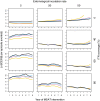Modelling the cost-effectiveness of mass screening and treatment for reducing Plasmodium falciparum malaria burden
- PMID: 23286228
- PMCID: PMC3544609
- DOI: 10.1186/1475-2875-12-4
Modelling the cost-effectiveness of mass screening and treatment for reducing Plasmodium falciparum malaria burden
Abstract
Background: Past experience and modelling suggest that, in most cases, mass treatment strategies are not likely to succeed in interrupting Plasmodium falciparum malaria transmission. However, this does not preclude their use to reduce disease burden. Mass screening and treatment (MSAT) is preferred to mass drug administration (MDA), as the latter involves massive over-use of drugs. This paper reports simulations of the incremental cost-effectiveness of well-conducted MSAT campaigns as a strategy for P. falciparum malaria disease-burden reduction in settings with varying receptivity (ability of the combined vector population in a setting to transmit disease) and access to case management.
Methods: MSAT incremental cost-effectiveness ratios (ICERs) were estimated in different sub-Saharan African settings using simulation models of the dynamics of malaria and a literature-based MSAT cost estimate. Imported infections were simulated at a rate of two per 1,000 population per annum. These estimates were compared to the ICERs of scaling up case management or insecticide-treated net (ITN) coverage in each baseline health system, in the absence of MSAT.
Results: MSAT averted most episodes, and resulted in the lowest ICERs, in settings with a moderate level of disease burden. At a low pre-intervention entomological inoculation rate (EIR) of two infectious bites per adult per annum (IBPAPA) MSAT was never more cost-effective than scaling up ITNs or case management coverage. However, at pre-intervention entomological inoculation rates (EIRs) of 20 and 50 IBPAPA and ITN coverage levels of 40 or 60%, respectively, the ICER of MSAT was similar to that of scaling up ITN coverage further.
Conclusions: In all the transmission settings considered, achieving a minimal level of ITN coverage is a "best buy". At low transmission, MSAT probably is not worth considering. Instead, MSAT may be suitable at medium to high levels of transmission and at moderate ITN coverage. If undertaken as a burden-reducing intervention, MSAT should be continued indefinitely and should complement, not replace, case management and vector control interventions.
Figures




References
-
- Kern SE, Tiono AB, Makanga M, Gbadoe AD, Premji ZG, Gaye O, Sagara I, Ubben D, Cousin M, Oladiran F, Sander O, Ogutu B. Community screening and treatment of asymptomatic carriers of Plasmodium falciparum with artemether-lumefantrine to reduce malaria disease burden: a modelling and simulation analysis. Malar J. 2011;10:210. doi: 10.1186/1475-2875-10-210. - DOI - PMC - PubMed
-
- Dondorp AM, Yeung S, White L, Nguon C, Day NP, Socheat D, von Seidlein L. Artemisinin resistance: current status and scenarios for containment. Nat Rev Microbiol. 2010;8:272–280. - PubMed
-
- Griffin JT, Hollingsworth TD, Okell LC, Churcher TS, White M, Hinsley W, Bousema T, Drakeley CJ, Ferguson NM, Basanez M, Ghani AC. Reducing Plasmodium falciparum malaria transmission in Africa: a model-based evaluation of intervention strategies. PLoS Med. 2010;7:e1000324. doi: 10.1371/journal.pmed.1000324. - DOI - PMC - PubMed
Publication types
MeSH terms
Substances
LinkOut - more resources
Full Text Sources
Other Literature Sources
Miscellaneous

